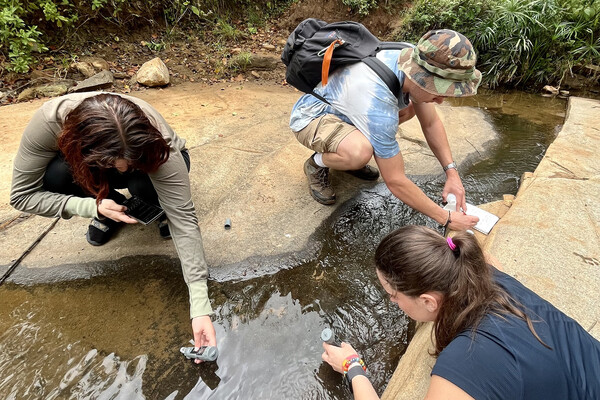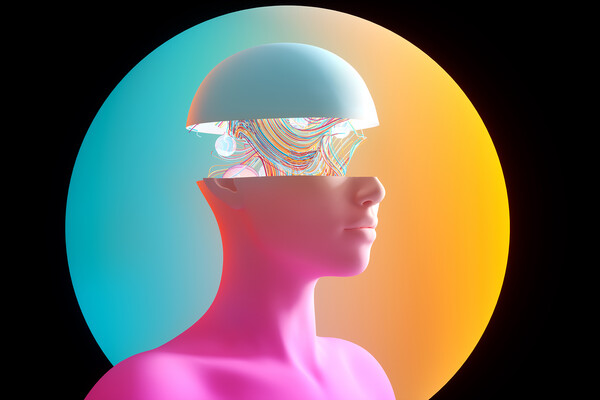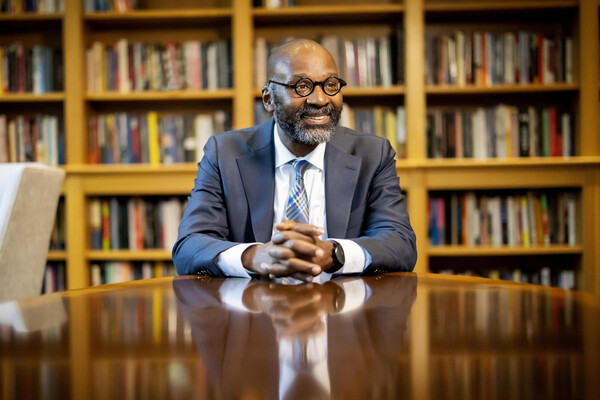
Griffin Pitt, right, works with two other student researchers to test the conductivity, total dissolved solids, salinity, and temperature of water below a sand dam in Kenya.
(Image: Courtesy of Griffin Pitt)
3 min. read
On May 10, the 19th International Architecture Exhibition opened in Venice, featuring installations and presentations from a global network of architects, designers, artists, and educators on the theme of “Intelligens. Natural. Artificial. Collective.” The effort to rethink the relationship between architecture and the environment is apparent in the many concurrent exhibitions around the city, notably the European Cultural Centre’s “Time Space Existence.” Work from more than half a dozen members of Penn’s Weitzman School of Design community is on display in Venice’s pavilions and palazzos through November.
Associate professor of landscape architecture Robert Gerard Pietrusko’s installation ”A Satellite Symphony,” made with design firm Space Caviar and astrophysicist Ersilia Vaudo of the European Space Agency, explores how satellites frame how we understand the Earth itself.
Winka Dubbeldam, professor and director of Advanced Research & Innovation Lab (ARI) and founder/principal of Archi-Tectonics, has a trio of offerings: “Hopeful Monsters,” which showcases a 47-hectare masterplan of hybrid taxonomies and rammed-earth structures in Hangzhou, China, in the Arsenale; masterplans to rewild the city of Tiranë, which will be presented in the Albanian pavilion in the Giardini; and a panel of international architects, writers, and publishers at Palazzo Bembo, to explore her firm’s new monograph “Strange Objects, New Solids and Massive Forms.”
Weitzman Lecturer and founding partner of GRO Architects Richard Garber is exhibiting projects built in Jersey City and Newark which explore the potentials of microhousing, modular construction, and adaptive reuse. Hina Jamelle, associate professor of practice in architecture and co-founder of Contemporary Architecture Practice, has curated a selection of projects from the Graduate Urban Housing Studios in an exhibit of student work that addresses the adaptive reuse of commercial office buildings for residential purposes.
Associate professor of architecture and director of the Polyhedral Structures Lab Masoud Akbarzadeh is also showing among the palazzos, offering a small-scale version of a large-scale concrete beam which resulted from a three-year collaboration with Sika Group Switzerland. Innovation in materials and construction is the focus of VAMO, a joint effort between ETH Zurich and MIT with contributions from assistant professor of architecture Laia Mogas-Soldevila and a team of master’s and Ph.D. students from Weitzman involved with her DumoLab Research.
Innovative materials and production are also explored in an exhibition by Mette Ramsgaard Thomsen, the Cret Chair Professor of Practice in architecture. The collaboration with the Danish firm 3XM, Thomsen says, is intended to explore “how the desire to work in a circular design paradigm allows us to reroute architecture into ideas of locality.”
Randy Mason, the director of Weitzman’s Urban Heritage Project and a professor of historic preservation, city and regional planning, and landscape architecture, is exhibiting “Reflected Heritage” “to deploy forms of data and representation created to document and manage National Park buildings and landscape as virtual cultural landscapes,” he says.
Marion Weiss, the Graham Professor of Practice in architecture and co-founder of WEISS/MANFREDI, is displaying, in the part of the Arsenale devoted to the theme of “intelligence”, recent projects including the designs for Hunters Point South Waterfront Park in New York City and Longwood Gardens in Pennsylvania.
These faculty are looking globally for ways to appreciate and innovate the American landscape—and they’re also looking locally. “The social and cultural agenda is really strong at Penn,” Dubbeldam says. “The Biennale gives us the chance to actually put it out into the world and say: Well, if you wanted to put us in a box, we would like to escape that box. That’s what we’re working on.”
Read more at Weitzman News.
From the Weitzman School of Design

Griffin Pitt, right, works with two other student researchers to test the conductivity, total dissolved solids, salinity, and temperature of water below a sand dam in Kenya.
(Image: Courtesy of Griffin Pitt)

Image: Andriy Onufriyenko via Getty Images

nocred

Provost John L. Jackson Jr.
nocred